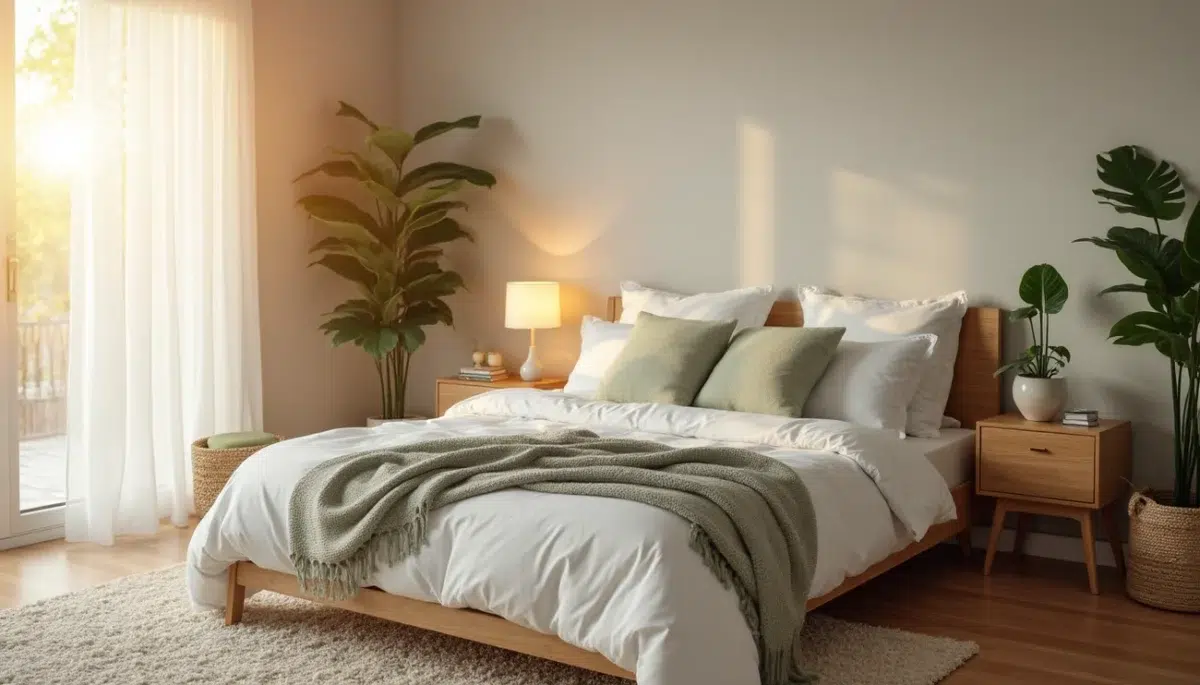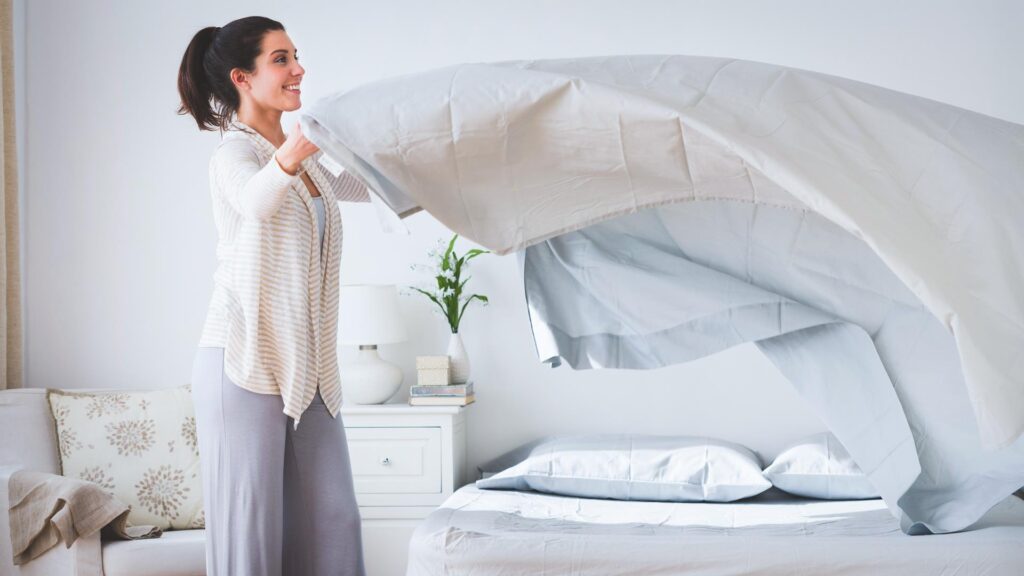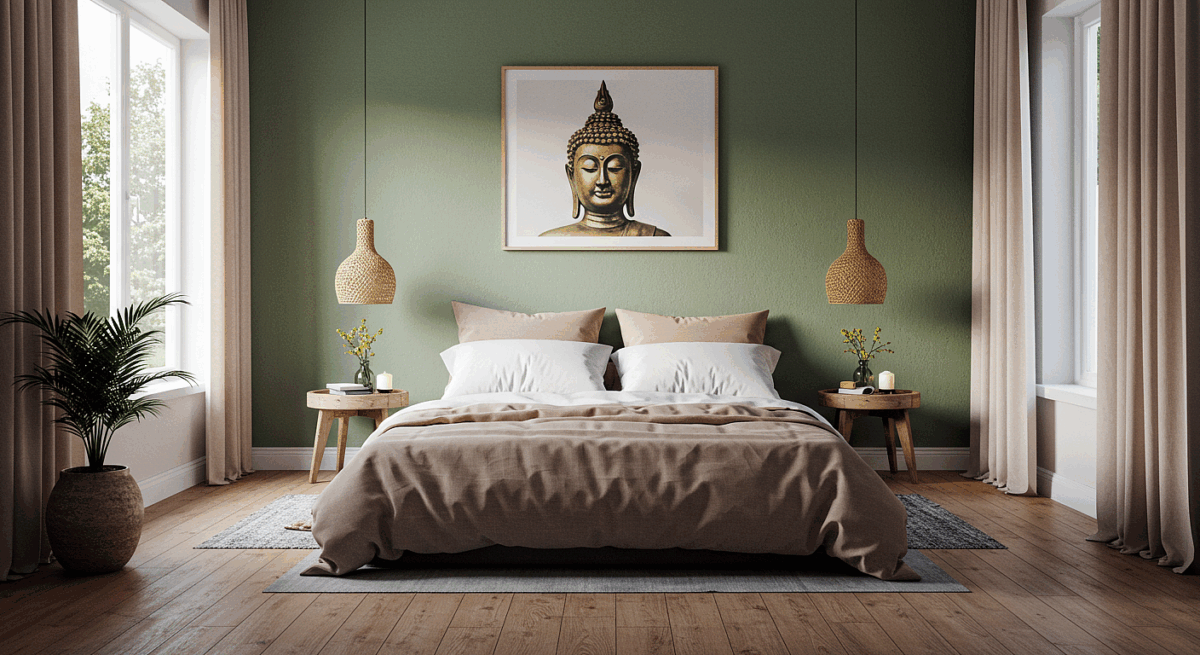Sleep Talk Blog, Health & Wellbeing, Inspire me
How to Create a Wellness Bedroom: A Simple Guide to Peaceful Sleep
Table of Contents
Home gyms and wellness bedroom ideas have become incredibly popular in recent years, with searches jumping by 61,000 in January 2025 compared to January 2019. That's quite a leap, isn't it?
But here's what's interesting – despite this growing trend, research shows that only 11% of adults in the UK actually use meditation as a relaxation technique. This suggests that whilst many of us are craving personal spaces for wellbeing, we might not be making the most of them once we've got them.
Why create a wellness bedroom in your home?
Your wellness room should be more than just another trendy home addition. It's about creating a sanctuary that genuinely benefits your mental health. A thoughtfully designed relaxing bedroom can boost positivity by enhancing focus, motivation and productivity. Better still, these personal spaces help reduce anxiety by providing a safe environment to decompress and recharge whenever you need it.
The affordable approach to wellbeing
With energy bills rising and money worries affecting people's mental wellbeing, you don't need to break the bank to prioritise your health at home. Natural light, which boosts energy levels and increases happiness, can be easily incorporated into your relaxing room ideas to create environments that truly support your wellbeing.
Whether you want to create a calming meditation corner or design a peaceful bedroom retreat, there are endless wellness room possibilities for you to explore. And the best part? You can create your own wellness sanctuary in just a weekend.
Ready to design your perfect peaceful retreat? This guide will walk you through everything you need to know about creating a wellness space that works for your lifestyle, budget and wellbeing goals.
The wellness room benefits that actually matter
Your dedicated wellness space offers far more than Instagram-worthy aesthetics. Research shows that wellness spaces can reduce stress by up to 60% after just 15 minutes of use, making them genuinely powerful tools for improving your daily life.
Mental health and stress relief
Think about how different environments affect your mood. A cluttered, noisy kitchen versus a serene garden – you can feel the difference immediately, can't you?
Wellness rooms work the same way. They provide sanctuaries where you can escape everyday pressures and process emotions in complete privacy. These dedicated spaces help lower blood pressure, decrease heart rate, and activate your body's relaxation response.
What's particularly interesting is how they create opportunities for mindfulness practises that measurably reduce anxiety and stress. Workplace wellness rooms have been shown to decrease rates of burnout and foster greater resilience – principles that work just as well in your own home.
Improved sleep and focus
The conditions in your sleeping environment directly impact sleep quality, which determines your overall health. A properly designed wellness room, especially one doubling as a relaxing bedroom, helps optimise your sleep-wake patterns through controlled lighting, temperature, and sound.
The result? Improved cognitive function during your waking hours. Research confirms that inadequate sleep negatively affects productivity, health, and wellbeing, making a calming bedroom essential for anyone seeking better rest and mental clarity.

Takeaway Tip: Even 20 minutes in a well-designed wellness space before bedtime can significantly improve your sleep quality.
A space for daily self-care

Establishing a consistent self-care routine becomes remarkably easier when you have a dedicated space for it. Your wellness room provides the perfect framework for practises that support long-term health – from meditation and stretching to simply disconnecting from technology.
Having this designated area makes self-care practises more accessible and sustainable. Research indicates that forming new habits typically takes about 66 days, and a consistent environment significantly increases your chances of successfully establishing positive routines that benefit both mental and physical health.
Don't forget, the beauty of a wellness room lies in its versatility – it adapts to whatever form of self-care you need on any given day.
How do you design the perfect foundation for your wellness space?
Creating an effective foundation for your wellness room starts with thoughtful planning. The physical environment you create will determine how well your space serves your wellbeing needs.
Pick a quiet, low-traffic room
Location makes all the difference when it comes to your wellbeing room's effectiveness. You'll want to select a space away from the bustle of main living areas to provide a genuine retreat. Corner locations generally work better than central areas, particularly as 56% of people feel embarrassed about focusing on mental health.
Here's what to consider when selecting your space:
- Choose a room that's easily accessible yet sufficiently private
- Avoid high-traffic areas where family members or flatmates regularly pass through
- If space is limited, use acoustic or privacy screens to create separation
- Consider unused guest rooms or outdoor structures for complete privacy
Choose a theme: spa, gym, or meditation
Your wellness room theme should align with your specific wellbeing goals. Deciding on a primary purpose helps anchor all your design decisions. A meditation-focused space requires minimal furniture and distractions, whereas a home gym needs more robust flooring and energising décor. Spa-themed rooms benefit from soothing colours and comfortable seating, creating a tranquil atmosphere similar to professional wellness centres.
Takeaway Tip: choosing one primary function will help you make better design decisions and create a more effective space.
Plan for natural light and ventilation
Natural light plays a crucial role in emotional wellbeing, with research showing it significantly impacts perceptions of happiness. Maximising daylight entering your relaxing room creates greater emotional benefits, particularly for women and young people.
Proper ventilation is equally important for healthy indoor air quality, as people spend approximately 90% of their time in enclosed spaces. Throughout your planning process, prioritise rooms with windows that face the sun and ensure adequate airflow. For spaces with limited natural light, consider lighting systems that mimic natural daylight patterns to help regulate your circadian rhythms and promote better sleep quality.
What decor choices will create your perfect wellness sanctuary?
The aesthetic elements you choose for your wellness space can make all the difference between an ordinary room and a sanctuary that truly nourishes your mind and spirit. Your decor choices have the power to support relaxation and restoration in ways that genuinely surprise you.
Keep furniture minimal and purposeful
Simplicity is your best friend when designing an effective wellness room. Select only a few pieces of high-quality furniture to maintain a serene, uncluttered environment. Rather than filling every corner, focus on creating openness and flow throughout your space.
A clean, simple ambience is particularly important for meditation spaces, where mental clarity is essential. Consider a comfortable cushion or meditation mat as your primary seating, alongside minimal storage like a rattan chest to keep personal items discreetly tucked away.
Embrace earth-tone colour palettes
The colours surrounding you profoundly influence your mood and mental state. For your wellness space, embrace neutral, soothing tones that create a genuine sense of stillness. Some of the most effective options include:
- Warm whites and creams for purity and simplicity
- Sage green for balance and harmony
- Earthy taupe and brown for security and grounding
- Blush pink for subtle warmth
Moka Mousse, a warm rich brown and Pantone's colour of the year, embodies security and safety—perfect for your mindfulness room.
Layer textures and lighting for comfort
Tactile pleasure from soft textiles alleviates stress and anxiety. Incorporate plush fabrics, velvet cushions, and woollen throws to create a multi-sensory experience that invites you to truly unwind.
Meanwhile, layered lighting combines three key elements: ambient, task, and accent lighting. This approach allows your space to adapt beautifully to different uses throughout the day. Incorporate dimmable fixtures that shift from cool and clear in the morning to warm and soothing in the evening.
Design a calming bedroom sanctuary
If your wellness room doubles as a bedroom, prioritise decluttering above all else—a clear space promotes a clear mind. Choose deeper tones like forest greens or stormy greys for cosy, cocooning vibes.

Invest in quality bedding and consider adding houseplants to your space. Not only do they purify the air, but certain varieties can remove up to 87% of air toxins in just 24 hours. Your wellness bedroom should feel like a retreat you genuinely look forward to entering each evening.
How do you keep your wellness sanctuary peaceful?
Your wellness space needs just as much attention to maintain as it did to create. Studies show that excessive clutter can increase stress and make it difficult to focus or relax, which rather defeats the purpose of your wellbeing room, doesn't it?
Simple daily habits that make a difference
Consistent tidying routines prevent your sanctuary from becoming another source of stress. These quick habits will keep your space serene:
- Make your bed every morning - this simple act sets a positive tone for the day
- Put away items immediately after use rather than allowing them to accumulate
- Take five minutes each evening to restore your calming bedroom to its peaceful state
- Sort mail upon arrival to prevent paper clutter from building up
Scents that support your wellbeing
The right fragrances can enhance your relaxing room ideas significantly. Lavender and chamomile promote relaxation, whilst citrus and peppermint invigorate. Choose warmer fragrances like amber, cinnamon and patchouli during winter months to create a cosy atmosphere in your wellbeing room.
Create your tech-free sanctuary

True restoration requires switching off from digital distractions. Research shows that constant notifications increase cognitive overload and contribute to burnout. Keep devices away from your wellness room and designate specific tech-free hours in this space. This practice reduces stress and fosters mindfulness—some companies now incorporate digital detox zones that have been shown to enhance focus and reduce burnout.
Low-maintenance greenery that works
Artificial plants offer all the calming benefits of nature without the upkeep demands. They stay vibrant regardless of lighting conditions and eliminate worries about allergies or care routines. High-quality faux plants can transform bland corners of your relaxing bedroom, bringing life to spaces where real plants would struggle due to insufficient sunlight.
Your wellness sanctuary awaits
Creating your own wellness room isn't just about following the latest home design trend – it's about giving yourself permission to prioritise your mental wellbeing in today's busy world. Your dedicated wellness space can genuinely reduce stress, improve sleep quality, and provide that essential sanctuary for daily self-care practices you've been craving.
The foundation of your wellness journey starts with smart planning. Finding that quiet corner away from daily chaos, choosing your focus (whether that's meditation, spa-like relaxation, or fitness), and embracing natural light creates the perfect environment for restoration. Add minimalist furniture, soothing earth tones, and those all-important soft textures, and you'll have transformed an ordinary room into a powerful wellbeing sanctuary worth talking about.
Keeping your peaceful retreat fresh
Your wellness space needs consistent love and attention to stay effective. Those daily decluttering habits, seasonal scent updates, and tech-free boundaries all work together to preserve the calming atmosphere you've worked hard to create. Remember, the true value of your wellness room lies in how it continues to serve your wellbeing needs day after day.
Whether you're converting an unused corner, giving a spare room new purpose, or adding wellness elements to your existing bedroom, the benefits speak for themselves. This personal sanctuary gives you a dedicated space to disconnect, recharge, and focus on yourself – something we all need but often struggle to prioritise.
Don't wait for the perfect moment to start your wellness room project. Even small changes can make remarkable differences to your mental health, sleep quality, and overall happiness. Your weekend wellness project could be the best investment you make in yourself this year.
Ready to create your own peaceful retreat? Your future self will thank you for taking this important step towards better wellbeing.
Key Takeaways
Creating a wellness room isn't just about following trends—it's about establishing a dedicated sanctuary that genuinely supports your mental health and daily wellbeing practises.
• Choose a quiet, low-traffic location with natural light and proper ventilation to maximise the space's restorative benefits
• Embrace minimalist furniture, earth-tone colours, and soft textures to create a calming environment that reduces stress by up to 60%
• Maintain your sanctuary through daily decluttering habits, tech-free zones, and seasonal scent updates to preserve its peaceful atmosphere
• Focus on one primary purpose—meditation, spa relaxation, or fitness—to anchor your design decisions and maximise effectiveness
Even small changes to create a dedicated wellness space can yield remarkable improvements in sleep quality, stress levels, and overall life satisfaction. The key is consistency in both creating and maintaining your personal retreat.
FAQs
Q1. What are the key elements to include in a wellness room?
A wellness room should have comfortable seating, soft lighting, calming colours, and minimal clutter. Consider adding elements like a meditation cushion, soothing artwork, and plants. Ensure good ventilation and natural light if possible, and include storage for wellness-related items.
Q2. How can I maintain a peaceful atmosphere in my wellness space?
Establish daily decluttering habits, use refreshing scents seasonally, and create tech-free zones to minimise distractions. Regularly update decor elements to keep the space inviting, and consider using artificial plants for low-maintenance greenery.
Q3. What colour scheme works best for a relaxing room?
Earth tones are ideal for a wellness room. Consider warm whites, sage green, taupe, and blush pink. These colours create a soothing atmosphere and promote feelings of calm and balance.
Q4. How can I create a wellness room if I have limited space?
If space is limited, consider transforming a corner of your bedroom into a wellness area. Use room dividers or screens for privacy, and focus on multifunctional furniture. Even a small, dedicated area can be effective for meditation or relaxation practises.
Q5. What are the benefits of having a dedicated wellness room?
A wellness room can significantly reduce stress, improve sleep quality, and provide a space for daily self-care. It offers a sanctuary for mental health, can enhance focus and productivity, and creates an opportunity to disconnect from daily pressures and technology.

